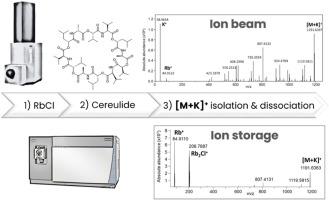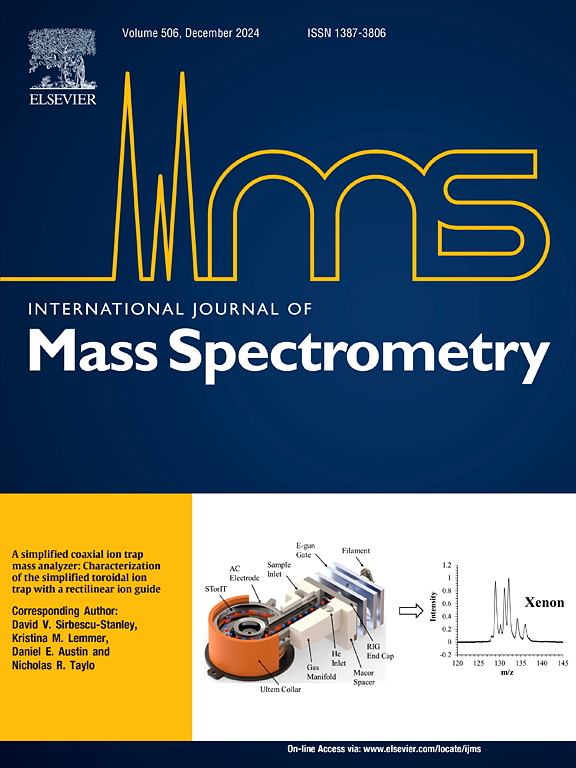揭示意想不到的:铈离子分子物种碰撞激活中的形式电荷交换
IF 1.7
3区 化学
Q3 PHYSICS, ATOMIC, MOLECULAR & CHEMICAL
引用次数: 0
摘要
在正电喷雾解吸/电离质谱(ESI-MS)条件下,细菌环沉积肽毒素cereulide [(D)Ala-(L)OVal-(L)Val-(D)OLeu]3主要以铵加合物和碱阳离子形式解吸。除了天然存在的碱阳离子(Li+/Na+/K+)外,在加入其氯盐(RbCl)溶液后,Rb+还可以附着在分子上。利用四极杆飞行时间(Qq/TOF)仪器,在非共振碰撞诱导离解(non-谐振CID)下,最近在非共振CID光谱中检测到裸碱阳离子。利用能量分辨质谱(ERMS)对阳离子化铈进行了研究,发现电荷溶剂化(CS)和质子化盐(PS)互变异构体共存。在离子源中注入含有RbCl盐的cereulide溶液,当选择无rb的物种([M + NH4]+, [M+Na]+或[M+K]+)进行后续破碎时,意外地检测到85Rb+和87Rb+在其自然丰度范围内。为了阐明这些意想不到的阳离子的来源,使用基于orbitrap的仪器对各种电离的铈化物进行了ERMS。奇怪的是,除了意想不到的Rb+同位素阳离子外,在[M+ NH4]+、[M+Na]+和[M+K]+的非共振CID光谱中大量检测到Rb2Cl+同位素,但在[M+85Rb]+中却没有检测到。进一步的计算和ERMS对数图可以排除Rb2Cl+和Rb+同位素可能的内源性起源。它们是在高能碰撞解离(HCD)电池中电离的核素(和b(12-n)离子)之间的离子/分子反应产生的,由缓冲气体松弛,中性RbCl同位素盐存在于气相中。后者可能是在RbnCl(n-1)+簇解离的初步研究中产生的,在较小的簇离子和中性RbCl损失中,或者是在HCD电池表面与缓冲气体碰撞时产生的。因此,Rb2Cl+同位素物不是85Rb+ + 87Rb+的前体。本文章由计算机程序翻译,如有差异,请以英文原文为准。

Revealing the unexpected: formal charge exchanges in collisional activation of cereulide ionized molecular species
Under positive electrospray desorption/ionization mass spectrometry (ESI-MS) conditions, a bacterial cyclodepsipeptide toxin, cereulide [(D)Ala-(L)OVal-(L)Val-(D)OLeu]3, is mainly desorbed as ammonium adduct and alkali-cationized species. In addition to the naturally occurring alkali cation (Li+/Na+/K+), Rb+ can be attached to the molecule after addition of its chlorine salt (RbCl) solution. Under non-resonant collision-induced dissociations (non-resonant CID) using a quadrupole time-of-flight (Qq/TOF) instrument, bare alkali cations were recently detected in non-resonant CID spectra. Investigation using energy-resolved mass spectrometry (ERMS) of cationized cereulide revealed coexistence of charge-solvated (CS) and protonated salt (PS) tautomers. Infusion of cereulide solution containing RbCl salt into the ion source led to the unexpected detection of 85Rb+ and 87Rb+ within their natural abundances when Rb-free species ([M + NH4]+, [M+Na]+ or [M+K]+) were selected for subsequent fragmentation. To elucidate the origin of these unexpected cations, ERMS of the various ionized cereulide species was carried out using an Orbitrap-based instrument. Curiously, in addition to the unexpected Rb+ isotopique cations, Rb2Cl+ isotopologues were abundantly detected in non-resonant CID spectra of [M + NH4]+, [M+Na]+, and [M+K]+, but not of [M+85Rb]+. Additional calculations and ERMS logarithmic plots made it possible to rule out a possible endogenous origin of the Rb2Cl+ and Rb+ isotopologues. They are produced by ion/molecule reactions in the higher-energy collisional dissociation (HCD) cell between ionized cereulide (and b(12-n) ions), relaxed by the buffer gas, and neutral RbCl isotopologue salts present in gas phase. The latter are likely generated either during preliminary studies of RbnCl(n-1)+ cluster dissociation in smaller cluster ions and neutral RbCl loss, or from the HCD cell surface by collisions with the buffer gas. Consequently, Rb2Cl+ isotopologues are not precursors of 85Rb+ plus 87Rb+.
求助全文
通过发布文献求助,成功后即可免费获取论文全文。
去求助
来源期刊
CiteScore
3.60
自引率
5.60%
发文量
145
审稿时长
71 days
期刊介绍:
The journal invites papers that advance the field of mass spectrometry by exploring fundamental aspects of ion processes using both the experimental and theoretical approaches, developing new instrumentation and experimental strategies for chemical analysis using mass spectrometry, developing new computational strategies for data interpretation and integration, reporting new applications of mass spectrometry and hyphenated techniques in biology, chemistry, geology, and physics.
Papers, in which standard mass spectrometry techniques are used for analysis will not be considered.
IJMS publishes full-length articles, short communications, reviews, and feature articles including young scientist features.

 求助内容:
求助内容: 应助结果提醒方式:
应助结果提醒方式:


